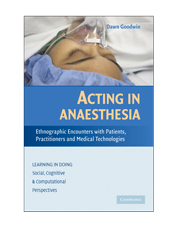Book contents
- Frontmatter
- Contents
- Series Foreword
- Acknowledgements
- Acting in Anaesthesia: Ethnographic Encounters with Patients, Practitioners and Medical Technologies
- 1 Understanding Anaesthesia: Theory and Practice
- 2 Refashioning Bodies, Reshaping Agency
- 3 Accounting for Incoherent Bodies
- 4 Teamwork, Participation and Boundaries
- 5 Embodied Knowledge: Coordinating Spaces, Bodies and Tools
- 6 Recognising Agency, Legitimating Participation and Acting Accountably in Anaesthesia
- References
- Index
- Titles in the series
2 - Refashioning Bodies, Reshaping Agency
Published online by Cambridge University Press: 20 August 2009
- Frontmatter
- Contents
- Series Foreword
- Acknowledgements
- Acting in Anaesthesia: Ethnographic Encounters with Patients, Practitioners and Medical Technologies
- 1 Understanding Anaesthesia: Theory and Practice
- 2 Refashioning Bodies, Reshaping Agency
- 3 Accounting for Incoherent Bodies
- 4 Teamwork, Participation and Boundaries
- 5 Embodied Knowledge: Coordinating Spaces, Bodies and Tools
- 6 Recognising Agency, Legitimating Participation and Acting Accountably in Anaesthesia
- References
- Index
- Titles in the series
Summary
The purpose of anaesthesia is to temporarily insulate a patient's senses from the trauma of surgery. This necessitates a reconfiguration of bodily boundaries and a redistribution of bodily functions. Anaesthetic machines are called upon to assume some of these responsibilities, for example, frequently patients are paralysed in the process of anaesthesia thus disabling their capacity to breathe, and the anaesthetic machine, once programmed, will then assume this responsibility. Furthermore, in rendering the patient unconscious, anaesthesia incurs a silencing of the patient. Here, anaesthetic machines are again enrolled to provide an alternative route of expression with monitoring devices displaying ‘readings’, diagrammatic ‘traces’ and measurements. An anaesthetised patient, therefore, is heavily reliant on the relationship that is forged with the anaesthetic machine. Indeed, the patient is technologically extended and augmented through this relationship. In a very practical and material sense, the patient becomes a mix of organic and technological components, in other words, a cyborg.
Cyborgs: Fact, Fiction and Social Reality
The word ‘cyborg’ was coined in 1960 by Clynes and Kline, as short for ‘cybernetic organism’. It referred to a living creature enhanced by computer-controlled bio-feedback systems, developed in the aim of liberating the human from environmental constraints:
The Cyborg deliberately incorporates exogenous components extending the self-regulatory control function of the organism in order to adapt it to new environments.
(Clynes and Kline, [1960] 1995: 31)Space travel, according to Clynes and Kline, would be better facilitated by modifying the body in partial adaptation to space conditions rather than persisting in carrying the earth's environment into space.
- Type
- Chapter
- Information
- Acting in AnaesthesiaEthnographic Encounters with Patients, Practitioners and Medical Technologies, pp. 33 - 60Publisher: Cambridge University PressPrint publication year: 2009



